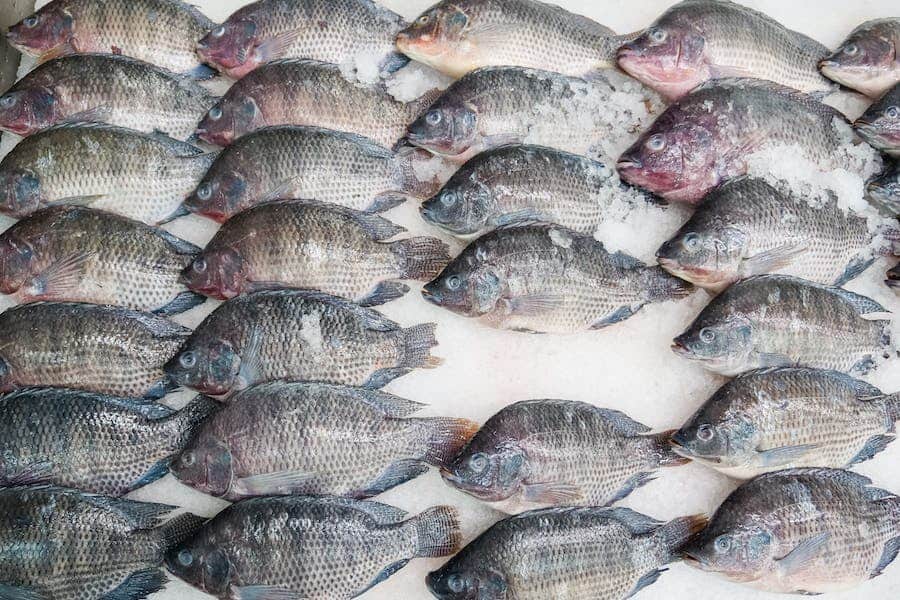Tilapia, a widely consumed fish species known for its mild flavor and versatility in various culinary dishes, has garnered significant attention and scrutiny in recent years. One of the critical questions that often arises in discussions about tilapia is whether it is a bottom feeder. This inquiry stems from concerns about the fish’s diet and its impact on its taste, quality, and suitability for consumption. In this article, we will delve into tilapia to unravel the truth about its feeding habits, exploring whether it is a bottom feeder or if there’s more to this popular fish than meets the eye.
Is Tilapia A Bottom Feeder?
Tilapia is often misunderstood as a bottom feeder, but the reality is more nuanced. While tilapia can sometimes be found foraging near the bottom of bodies of water, their primary diet consists of algae and aquatic plants. They are not true bottom feeders like catfish or carp, which actively scavenge the substrate for food. In aquaculture, tilapia diets are carefully controlled to ensure high-quality, nutritious meat. So, while they may occasionally graze near the bottom, it’s inaccurate to label tilapia as typical bottom feeders.
What Does “Bottom Feeder” Mean?
“Bottom feeder” is a term used to describe certain types of fish or aquatic organisms that exhibit feeding behaviors involving the consumption of food particles or organisms found at or near the bottom of a body of water. These organisms are typically specialized in their ability to scavenge, sift through, or otherwise obtain sustenance from the substrate or residue present on the water’s floor.
- Mouth And Body Adaptations: Many bottom feeders have specialized mouthparts or body structures that allow them to forage on the bottom effectively. These adaptations can include downward-facing mouths, barbels (whisker-like appendages), or even sucker-like mouths for adhering to surfaces.
- Dietary Preferences: Bottom feeders primarily consume detritus, small invertebrates, algae, and other organic matter on the bottom. They may also consume small prey that venture near or burrow into the substrate.
- Habitat And Behavior: Bottom feeders are often found in habitats with a significant presence of substrate, such as riverbeds, lake bottoms, and ocean floors. They are adapted to move along or through these surfaces for food.
- Omnivorous Or Herbivorous: While many bottom feeders are omnivorous, meaning they consume plant and animal matter, some may have a predominantly herbivorous diet, feeding primarily on algae and plants.
How Does Tilapia’s Diet Change In Aquaculture Settings?
Tilapia’s diet undergoes significant changes when raised in aquaculture settings as opposed to their natural habitat. These changes are carefully managed to optimize the growth, health, and quality of tilapia for human consumption. Here’s how tilapia’s diet changes in aquaculture settings:
Formulated Feeds:
In aquaculture, tilapia are fed formulated feeds designed to meet their nutritional requirements at various growth stages. These feeds contain various ingredients, including plant-based materials, grains, protein sources, vitamins, and minerals. Formulated feeds ensure that tilapia receive a consistent and balanced diet, promoting rapid growth.
Protein Sources:
Tilapia feeds in aquaculture contain protein sources that are cost-effective and sustainable. These include soybean meal, corn gluten meal, and other plant-based proteins. Using alternative protein sources helps reduce the reliance on fishmeal, often derived from wild-caught fish, and can contribute to overfishing.
Nutritional Balance:
The composition of formulated feeds is carefully balanced to provide essential nutrients such as amino acids, vitamins, and minerals. This balance ensures that tilapia receive all the necessary nutrients for growth, reproduction, and overall health.
Floating Pellets:
Tilapia feeds are often provided as floating pellets. This allows for easy monitoring of feeding behavior and reduces waste, as uneaten pellets are visible on the water’s surface and can be removed. Floating pellets also encourage tilapia to feed near the surface, making it easier for farmers to observe and manage their feeding.
Feeding Regimen:
Feeding times and frequencies are controlled in aquaculture settings to prevent overfeeding and maintain water quality. Tilapia are usually fed multiple times a day, with the quantity of food adjusted based on their age, size, and growth rate.
Supplemental Feeding:
Sometimes, tilapia may receive supplemental feeds to enhance growth or specific qualities. For example, some farmers use feeds containing natural pigments to improve the color of tilapia flesh, which can be appealing to consumers.
Environmental Considerations:
Aquaculture practices take into account the environmental impact of feeding. Proper management of feeding rates helps minimize the release of excess nutrients into the water, which can cause water quality issues and harm the surrounding ecosystem.
Research And Innovation:
Continuous research and innovation in aquaculture aim to improve the efficiency and sustainability of tilapia feeding. This includes the development of feeds with reduced environmental impact and the exploration of alternative ingredients.
Tilapia Feeding Habits
Tilapia, a widely cultivated fish species worldwide, exhibit varied feeding habits depending on their natural habitat and the conditions in which they are raised in aquaculture. Understanding their feeding habits is essential for maintaining their health and optimizing their growth in fish farms. Here’s an overview of tilapia feeding habits:
Herbivorous Nature: Tilapia are generally considered herbivorous fish. In their natural habitat, which includes freshwater lakes, rivers, and ponds in tropical and subtropical regions, they predominantly feed on aquatic plants, algae, phytoplankton, and detritus near the water’s surface.
Opportunistic Feeders: While tilapia are primarily herbivorous, they are opportunistic feeders. This means they may consume various food items depending on what’s available. In the wild, they might occasionally feed on small invertebrates, aquatic insects, or even smaller fish.
Dietary Adaptability: Tilapia can adapt their diets to available food sources. In aquaculture, this adaptability is utilized by fish farmers who provide formulated feeds. These feeds typically consist of plant-based ingredients, grains, and protein sources, and they can be tailored to meet the nutritional needs of tilapia at different growth stages.
Feeding Behavior In Aquaculture: In fish farms, tilapia are typically pelleted or extruded feeds. They readily accept these artificial feeds, which are nutritionally balanced to promote rapid growth. The use of formulated feeds allows for controlled and efficient feeding, reducing the environmental impact of excess uneaten food.
Consideration For Water Quality: Proper feeding management is crucial in tilapia aquaculture to maintain good water quality. Overfeeding can lead to excessive nutrient buildup, negatively impacting water quality and fish health. Therefore, feeding schedules and quantities are carefully monitored to ensure optimal growth without harming the aquatic environment.
Sustainable Feeding Practices: Sustainable aquaculture practices are increasingly important in tilapia farming. This includes using feeds that minimize the reliance on fishmeal and fish oil derived from wild-caught fish, as well as adopting environmentally friendly practices to reduce the ecological footprint of tilapia production.
The Popularity Of Tilapia Globally
The popularity of tilapia as a seafood choice has grown significantly globally over the past few decades. Several factors contribute to the widespread popularity of tilapia worldwide:
Tilapia is known for its mild and neutral flavor profile. Its relatively neutral taste makes it versatile and adaptable to various culinary styles and recipes. It’s a fish that appeals to a broad range of palates.
Affordability: Tilapia is often more affordable than many other seafood options, making it an accessible choice for consumers on various budgets. This affordability has contributed to its widespread consumption, particularly in regions where cost is a significant consideration for food choices.
Tilapia’s firm texture and mild taste make it a versatile ingredient in the kitchen. It can be grilled, baked, fried, or used in soups, stews, and salads. Its ability to absorb flavors from seasonings and sauces makes it a favorite among chefs and home cooks.
Tilapia is farmed in many parts of the world, and its availability is consistent throughout the year. This ensures a steady supply to meet consumer demand, reducing the reliance on seasonal catches.
Tilapia is perceived as a healthy protein choice. It is low in saturated fat, a good source of lean protein, and provides essential nutrients such as vitamin B12 and selenium. These attributes make it appealing to health-conscious consumers.
Tilapia farming has made significant strides in adopting sustainable practices. Many tilapia farms prioritize responsible aquaculture practices, reducing their environmental impact and addressing concerns about overfishing.
Tilapia’s acceptance varies by region, but it has gained popularity in many countries, becoming a staple in specific cuisines. Its versatility and adaptability make it easy to incorporate into various cultural dishes.
Tilapia farming is often seen as a solution to food security challenges, particularly in regions with limited access to traditional protein sources. Its rapid growth and efficient feed conversion rate make it a viable option for addressing protein needs.
Warping Up
Tilapia, while occasionally misconceived as a bottom feeder, is primarily a herbivorous fish with the ability to adapt its diet depending on its environment. In aquaculture settings, tilapia’s diet undergoes significant changes as they are provided with carefully formulated feeds to ensure their nutritional needs are met for optimal growth and health. This transition to formulated feeds allows for better control, sustainability, and efficiency in tilapia farming, contributing to its popularity as a seafood choice worldwide. The mild flavor, affordability, versatility, and perceived health benefits of tilapia have cemented its position as a favorite among consumers. As sustainable aquaculture practices continue to evolve, tilapia’s popularity is expected to persist, meeting the growing global demand for seafood.
FAQ’s
Is Tilapia A Healthy Fish To Eat?
Tilapia is considered a healthy choice as it is low in saturated fat, a good source of lean protein, and contains essential nutrients like vitamin B12 and selenium. However, its nutritional value can vary depending on diet and farming practices.
Where Is Tilapia Commonly Farmed?
Tilapia is farmed in many countries worldwide, with significant production in Asia, Africa, the Americas, and parts of Europe. It thrives in warm, freshwater environments and is well-suited to aquaculture.
Can I Farm Tilapia At Home?
Yes, it is possible to farm tilapia at home in a controlled environment, such as a backyard pond or an indoor aquarium. However, successful tilapia farming at home requires knowledge of their requirements and proper equipment and care.








